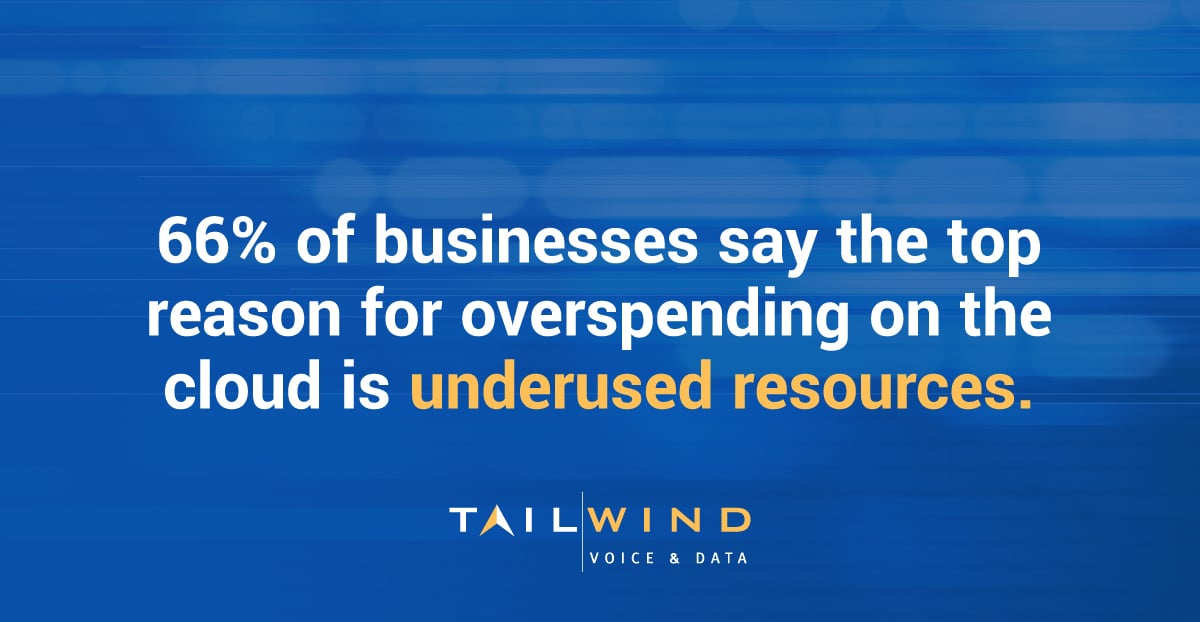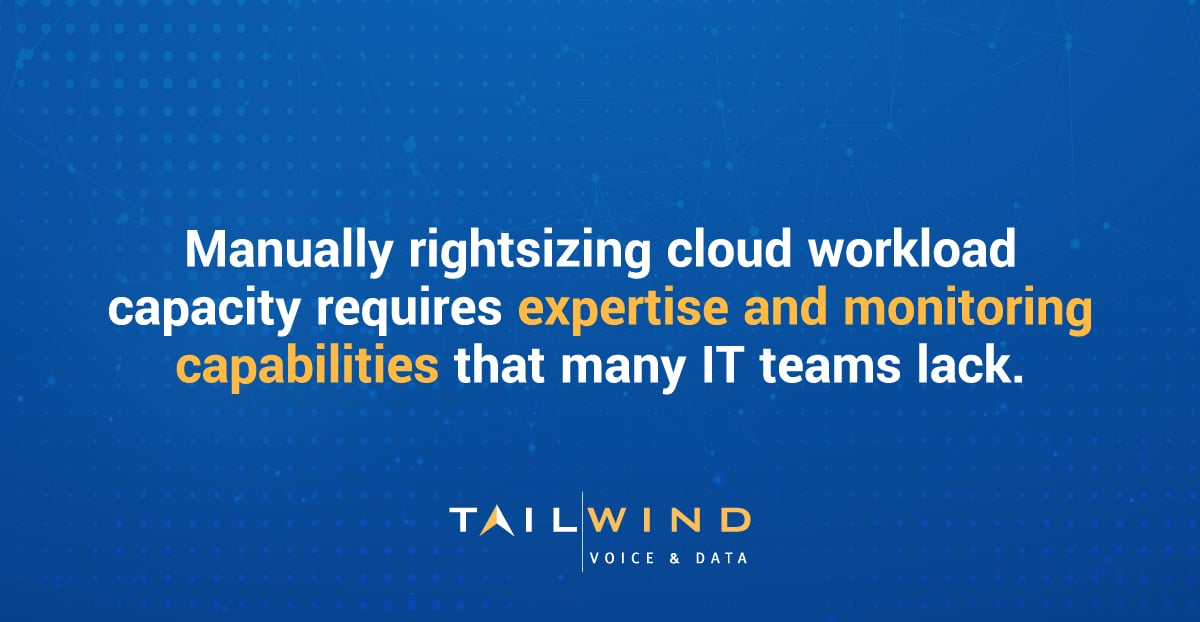As cloud adoption accelerates, more organizations are struggling to control runaway costs from their investments. Pay-as-you-go pricing models make cloud costs unpredictable, while ease of implementation often leads to deploying more services than your teams actually need. A 2022 survey found that 94% of enterprises are overpaying for cloud services, with 66% of respondents claiming underused resources as the top reasons for overspending.1 But while many public cloud providers offer basic cost management tools, businesses need more powerful solutions to gain full visibility and control over cloud spending.
In this blog, we explain the importance of cloud cost management for overcoming the key challenges businesses face in tracking and optimizing cloud costs.
What Is Cloud Cost Management?
Cloud cost management involves continuously monitoring, analyzing, and optimizing spending on an organization's cloud computing resources. By tracking usage and billing data, businesses can gain clearer insight into how and where their cloud budgets are allocated. This allows them to identify unused services and overprovisioning, enact policies for cost control, and more accurately forecast future cloud costs.
Cloud infrastructure is increasingly complex, making cloud costs difficult to track. To further complicate matters, the pay-as-you-go pricing used by many cloud providers can fluctuate significantly depending on the actual resources a business uses.
Proactive cost monitoring and management are critical for getting cloud costs under control. Cloud cost management helps by tracking the bills associated with a company's cloud use and allocating them to the teams responsible for their accumulation. With the right cloud cost management strategy in place, businesses can create a framework for budgeting and shared responsibility to ensure cloud resources are used with the appropriate controls.

The Importance Of Cloud Expense Management For Businesses
Cloud computing delivers immense advantages to businesses, such as rapid scalability without major upfront investments. By adopting next-generation cloud services, your IT teams can quickly roll out solutions and scale usage based on needs. However, the on-demand nature of the cloud also comes with the risk of unexpected costs that can easily exceed budgeted amounts – which is why implementing cloud cost management strategies has become essential.
Specialized cloud cost management services offer deep insights compared to solutions offered by cloud providers. With comprehensive cost visibility, businesses can pinpoint savings opportunities by enforcing accountability across all teams, optimizing the performance of cloud services, and strategically allocating workloads to the best environments.
6 Common Cloud Cost Management Challenges
Some of the biggest challenges businesses face when trying to manage cloud spending include:
Lack Of Visibility
In a dynamic cloud environment, usage and spending fluctuate frequently based on changing workload demands and traffic spikes. Manual tracking of cloud usage is time-consuming, incomplete, and always a step behind. Most organizations struggle to maintain clear visibility into their resource usage, making it nearly impossible to control cloud costs.
Complex & Distributed Billing
In large organizations and multi-location enterprises, cloud expenses are typically spread across several departments, projects, and branch offices. Multiple cloud services contribute to overall monthly bills that are complex and highly distributed, resulting in unexpected charges, budget overruns, and billing disputes between teams.
Inefficient Usage
Suboptimal usage patterns like idle instances, over-provisioned resources, and storage inefficiencies can easily bloat your cloud bill. Rightsizing cloud workloads for your organization's current usage needs can help with cost management, but doing so manually requires expertise and monitoring capabilities that most IT teams lack.
.jpg?width=850&height=741&name=tailwind_blog_cloudcostmanagement_inline2%20(1).jpg)
Uncontrolled Provisioning
Developers can provision cloud resources with a click of a button. But while self-service access can give your business more agility, it often leads to uncontrolled cloud provisioning. Forgotten test instances, unused storage volumes, and zombie virtual machines contribute to increased spending. Depending on the size of your cloud environment, manually overseeing cloud provisioning is simply too time-consuming.
Inaccurate Cost Allocation
Many businesses have internal models to determine how to allocate costs for shared cloud resources to departments, but manual allocation calculations are often error-prone, inconsistent, and difficult to verify. Without precise usage and spending data associated with each department, organizations can struggle to incentivize smart usage behavior or predict budget overruns in departments whose behavior is impacting shared cloud spend.
Poor Forecasting
The lack of visibility into historical cloud usage and spending patterns makes it difficult to predict future cloud expenses accurately. Actual cloud costs can double the original budgets due to unpredictable usage spikes and steady spend creep happening under the surface. Without clear insight into cloud usage trends, seasonal traffic patterns, and growing resource consumption, budget predictions are ineffective.
Building Cloud Cost Management Strategies
Identifying problems is only the first step. To truly control cloud spend, you need a structured strategy that combines education, clear ownership, and repeatable processes. A well-designed approach turns cloud cost management from a reactive exercise into an ongoing discipline.
Educating Stakeholders On Cloud Economics
Developers, IT leaders, and business stakeholders all influence cloud usage. When they understand how pricing works and which decisions drive costs, they can make smarter choices day to day. Short trainings, internal documentation, and cost review sessions help your teams connect architecture decisions to financial impact, instead of treating the cloud as a bottomless resource.
Establishing Governance & Guardrails
Without guardrails, it’s easy for cloud resources to grow faster than your ability to manage them. Defining who can provision which services, under what budget limits, and for which environments helps keep growth intentional. Standardized tagging policies, naming conventions, and approval workflows for new projects make it easier to track ownership and eliminate waste later.
Implementing Forecasting & Budgeting Processes
Cloud costs are variable by design, but they shouldn’t be unpredictable. Using historical usage trends, seasonality, and upcoming projects, you can create realistic forecasts and budgets for each department or application. Setting alerts for spending thresholds gives teams time to investigate anomalies before they turn into month-end surprises.
How FinOps Supports Cloud Cost Management
Cloud cost management works best when finance, IT, and business teams are aligned. That’s where FinOps comes in. FinOps is a cloud financial management practice that brings technical and financial stakeholders together around a shared goal: getting the most value from every dollar spent in the cloud.
What Is FinOps & Who’s Involved
A FinOps approach doesn’t replace your existing teams, it connects them. Engineering, operations, finance, procurement, and leadership all play a role. Engineering brings insight into workloads and technical requirements, finance brings budgeting and reporting discipline, and leadership sets the direction for how aggressively to optimize costs versus prioritize performance and growth.
Chargebacks, Showbacks & Accountability
To change behavior, teams need to see the impact of their decisions. Mapping cloud spend to business units, applications, or projects through chargebacks or showbacks gives everyone clear visibility into what they’re consuming. When teams see their share of the bill, they’re more likely to rightsize instances, shut down unused environments, and design architectures with efficiency in mind.
Creating A Cost-Aware Culture
FinOps is as much about culture as it is about tools. Regular cost reviews, dashboards that highlight spending trends, and transparent discussions about tradeoffs help keep cloud economics front and center. Over time, this creates a culture where efficiency is built into design decisions, not just considered when budgets are tight.
Cloud Cost Management & Optimization
While cloud cost management focuses on tracking detailed cloud usage data to allocate expenditures and generate spending reports, cloud cost optimization leverages these insights to minimize costs while aligning cloud resources with business objectives. Essentially, cloud cost management delivers visibility, while optimization reduces spending and improves performance and growth.
Cloud cost management:
- Tracks detailed cloud usage data.
- Attributes expenditures to teams and services.
- Generates cloud spending reports.
Cloud cost optimization:
- Actively calibrates cloud usage.
- Links infrastructure expenses directly to growth objectives.
- Balances cost savings with strategic investments.
- Weighs spending tradeoffs relative to revenue gains.

Key Factors That Drive Cloud Costs
Even before you look at vendor pricing models, the way your teams use the cloud has a direct impact on your monthly bill. Understanding the main cost drivers helps you see where waste is hiding and where optimization will move the needle most.
Resource Usage & Instance Types
Every virtual machine, container, and database instance you spin up consumes CPU, memory, and storage. Choosing an instance that’s larger than your workload needs means you’re paying for capacity you never use. On the other hand, running critical applications on underpowered instances can hurt performance and force you to scale out prematurely. Regularly reviewing instance families and sizes helps align resource consumption with actual demand.
Data Storage & Data Transfer
Cloud storage looks inexpensive at first glance, but costs can add up quickly when you factor in the volume of data stored, how often it’s accessed, and how frequently it’s moved between services or regions. Large volumes of logs, backups, and historical data can quietly accumulate, while cross-region replication and data egress fees inflate your bill. Building lifecycle policies and being intentional about where and how data is stored keeps these costs in check.
Licenses, Managed Services & Support
Cloud costs aren’t limited to infrastructure. Managed databases, analytics services, security tools, and third-party integrations all come with their own license or subscription fees. Support packages and training programs may also be billed separately. A comprehensive cost view must include these service layers so you’re not focusing on infrastructure savings while overspending on licenses you no longer need.
Geography & Deployment Location
Where you host your workloads matters. Different regions can have different pricing for the same service, influenced by local infrastructure, taxes, and energy costs. Hosting in a lower-cost region can reduce spend, but you need to weigh those savings against latency, regulatory requirements, and data residency rules. The most cost-effective setup balances infrastructure pricing with performance and compliance.
Common Cloud Cost Models & Components
Pricing for cloud services typically uses dynamic models that fluctuate based on changing supply, demand, and usage factors. Most cloud costs revolve around these three core components:
Compute
Cloud providers often offer varying tiers of compute instances featuring different CPU, memory, storage, and networking capacities. Customized hardware for graphics, high-speed processing, machine learning, and more is also available. Fees accumulate based on factors like chosen instance types, numbers provisioned, and runtime duration.
Network
Most public cloud providers charge based on the amount of data a business transfers to or from the cloud services. Supplementary networking services like static IPs, VPNs, and load balancing may incur additional fees.
Storage
Storage-as-a-service options simplify cloud data storage costs by offering monthly pricing that scales to provision capacity for managed storage services, such as a managed disk attached to a service's compute instance.
Here's an overview of the primary cloud cost models:
Flat Rate
Large enterprises can negotiate substantial discounts by committing to an upfront payment on Reserved Instances (RIs). This guarantees your business will receive a predefined number of cloud instances at locked-in rates, typically over one to three-year contract periods. While this option is expensive initially, the predictable workloads and service levels typically justify the capital outlay through long-term cost savings.
Pay-Per-Use
Pay-per-use plans allow businesses to dynamically scale their cloud services to match fluctuating demands by charging only for actual usage. If your organization has variable needs, this cost model can help ensure you're not overpaying for unused cloud resources to minimize waste. However, the lack of bulk discounts typically results in higher per-unit costs.
Spot Instances
Various cloud providers leverage spare capacity to sell discounted spot instances via bid-based auctions. Although cloud costs are extremely low with this model, instance availability varies according to supply-demand dynamics. A drawback of this option is that it's not predictable, so it's typically only suitable for organizations that prioritize cost savings over reliable access to cloud services.
Managing Cloud Costs In Hybrid & Multicloud Environments
Many organizations now run a mix of on-premises infrastructure, private cloud, and multiple public cloud providers. While this approach increases flexibility and resilience, it also adds complexity to cost management. Each environment has its own pricing model, invoices, and usage patterns that must be brought together into a single, coherent picture.
Why Hybrid & Multicloud Raise The Stakes
Fragmented workloads can dilute your buying power and make it harder to take advantage of volume discounts or reserved capacity. Different teams may choose different providers for similar workloads, resulting in parallel solutions and overlapping costs. Without a unified view, it’s difficult to understand total cloud spend or identify which platforms are truly delivering value.
Standardizing Policies Across Environments
The more environments you manage, the more important consistency becomes. Standardizing tagging, naming conventions, and governance policies across clouds and data centers makes it possible to compare costs and usage side by side. When every resource is tagged with the same set of attributes, such as owner, environment, and application, it’s much easier to track costs and enforce policies, regardless of where that resource runs.
Reducing Shadow IT & Unauthorized Cloud Usage
Hybrid and multicloud environments can unintentionally encourage shadow IT, where departments spin up services or accounts outside established processes. These unmanaged resources often lack proper security controls, monitoring, and cost visibility. Regular audits, centralized account management, and clear intake processes for new workloads help prevent uncontrolled sprawl and keep cloud usage aligned with your cost-management strategy.
Cloud Cost Management Best Practices
Once you have visibility and governance in place, the next step is to put practical techniques to work. These best practices help translate your strategy into day-to-day actions that reduce waste and keep your cloud footprint aligned with real business needs.
Rightsizing & Instance Optimization
Rightsizing is the ongoing process of adjusting instance types and sizes to match actual workload requirements. Instead of provisioning for peak usage 24/7, you can use monitoring data to see where CPU, memory, or storage are consistently underutilized. Moving those workloads to more appropriate instance types lowers costs while maintaining performance.
Autoscaling & Load Balancing For Variable Workloads
Not every workload justifies fixed capacity. Autoscaling policies allow you to scale resources up during peak demand and scale down when traffic is lighter, so you’re not paying for idle capacity. Paired with load balancing, autoscaling helps distribute traffic evenly across instances and keeps applications responsive without overprovisioning.
Power Scheduling For Non-Production Environments
Development, test, and staging environments rarely need to run around the clock. Implementing schedules that automatically shut down non-production resources during nights, weekends, or other low-usage windows is a simple way to trim costs. Over the course of a year, these incremental savings can add up significantly.
Cleaning Up Unused & Zombie Resources
Snapshots, unattached volumes, abandoned test instances, and outdated backups all consume capacity, and budget, without delivering value. Establishing a regular cleanup cadence to identify and remove unused resources helps you recover wasted spend. As an added benefit, cleaning up old environments reduces your attack surface and supports better security hygiene.
Using Discount & Spot Instances Strategically
Discounted options like reserved instances or spot instances can deliver major savings when used thoughtfully. Reserved instances work well for predictable, steady-state workloads, while spot instances are best suited for flexible, fault-tolerant jobs such as batch processing or test runs. Matching the right pricing option to the right workload helps you balance reliability with cost efficiency.
Cloud Cost Management FAQs
What Is The Difference Between Cloud Cost Management And Cloud Cost Optimization?
Cloud cost management focuses on tracking, allocating, and reporting on cloud spend so you know where your money is going. Cloud cost optimization uses those insights to actively reduce costs and improve efficiency, by rightsizing resources, cleaning up unused services, and aligning usage with business priorities.
Who Should Own Cloud Cost Management In An Organization?
Ownership is usually shared. IT or cloud operations teams manage the technical side, finance provides budgeting and reporting structure, and business leaders set priorities. A FinOps function often brings these stakeholders together and ensures that everyone has clear accountability for both usage and spend.
How Often Should We Review Our Cloud Spending?
At a minimum, monthly reviews help you spot trends and address issues before they compound. Many organizations add weekly or even daily checks for high-risk workloads or when rolling out new services. The more dynamic your cloud environment, the more frequently you should review key cost and usage metrics.
How Do Cloud Pricing Models Affect Budgeting And Forecasting?
Pay-as-you-go, reserved capacity, subscriptions, and spot pricing each behave differently over time. Pay-as-you-go offers flexibility but can introduce volatility, while reserved capacity and subscriptions improve predictability in exchange for longer commitments. Understanding how these models behave in your environment helps you build more accurate budgets and choose the right mix for your workloads.
Can We Still Optimize Costs If We’re Using Multiple Cloud Providers?
Yes, but it requires additional structure. Consistent tagging, centralized reporting, and clear governance policies across providers are essential. With those foundations in place, you can compare costs across clouds, identify duplication, and ensure each workload runs in the environment that offers the best balance of performance, compliance, and price.
Do We Need A Dedicated Tool To Manage Cloud Costs Effectively?
You can start with native cloud provider tools and spreadsheets, especially if your environment is relatively small. As your cloud usage grows, dedicated cost management platforms become more valuable by consolidating data, automating analysis, and surfacing optimization opportunities your teams might otherwise miss.
Tailwind Streamlines Managing Cloud Costs
Getting a handle on cloud costs is no longer optional – it's a strategic imperative. Implementing the right combination of cloud cost management tools, best practices, and organizational governance is essential for overcoming roadblocks like lack of visibility into usage trends and spending patterns.
If you're struggling to control your multi-location enterprise's cloud costs, TailWind can help. We offer professional telecom audits that provide visibility into your telecom, IT, and cloud environments, no matter how many locations or invoices your organization deals with day-to-day. Additionally, our telecom expense management services provide dedicated support to navigate the challenges of managing technology and optimizing spending. Get in touch with Tailwind today to learn more or get started.
Sources:


